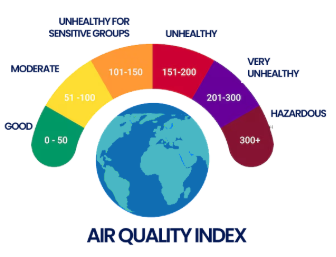
Make Sure the Air Out There Doesn’t Leave a Lasting Impression
Summer is prime outdoor time — and unfortunately, it’s also peak fire season. This year, Canada is having one of its top three worst fire seasons on record. Extreme drought conditions have turned vast stretches of land into tinderboxes, contributing to more than 16.3 million acres burned so far this year. Add to that another huge California fire (the Gifford fire) and another in Arizona and you have a perfect storm of noxious skies making outdoor time dangerous for many Americans.
What’s Going On — and Why the Air Feels So Terrible Right Now
Wildfires in the Western U.S. and Canada are releasing massive clouds of fine particles — called PM2.5 — and drifting them across thousands of miles. In early summer 2025, Toronto and Montreal recorded some of the worst air quality in the world because of this. Smoke has reached as far as Europe, and in parts of the West, AQI (Air Quality Index) values have soared into the hazardous range above 300.
This isn’t just smoky haze, it’s microscopic trouble. PM2.5 penetrates lungs, enters blood, and travels through your body. Short-term exposure can lead to coughing, wheezing, bronchitis, asthma flare-ups, heart attacks, and strokes. Long-term, there’s research suggesting these particles can even contribute to brain inflammation and cognitive decline.
Who’s Most at Risk?
If you’re older, very young, pregnant, or already dealing with lung or heart conditions (think asthma, COPD, diabetes), you’re especially vulnerable. Smoke exposure can aggravate preexisting conditions, increase ER visits, and heighten mortality risk.
Outdoor workers and communities with limited access to clean air (due to housing or economic constraints) often face higher exposures and more harm. Even mental health is at stake. Recent studies link wildfire smoke to heightened anxiety, depression, PTSD in survivors, and even spikes in suicides and overdoses tied to trauma and brain inflammation.
How to Know When You Should Limit Outdoor Activities
Bad air quality doesn’t always announce itself in an overt way, but that doesn’t mean that it is not harmful. Polluted air can cause difficulty breathing, allergy flare-ups, asthma attacks, and other lung problems. Bad air can cause spectacular headaches because it triggers certain neurons in your brain and can create disorientation, thanks to lower oxygen levels. Long-term exposure to air pollution can raise the risk of other diseases, including heart disease and cancer, because the particles you breathe in can turn up in your bloodstream and cause inflammation — a process that underlies many chronic illnesses.
During fire season, fires dominate local news stories. But it’s hard to know from horrifying images of burning acres how dangerous the air is for you, personally. But there are tools for that! One of the most popular and accurate measures is the Air Quality Index, or AQI. The AQI works like a thermometer that runs from 0 to 500 degrees. However, instead of showing changes in temperature, the AQI indicates changes in the amount of five main pollutants in the air:
- ground-level ozone
- particle pollution (also known as particulate matter, including PM2.5 and PM10)
- carbon monoxide
- sulfur dioxide
- nitrogen dioxide
All of these pollutants are harmful to breathe in. And like everything else, bad air takes the greatest toll on the most sensitive and vulnerable among us. That’s why the EPA created a color-coded warning system so that we know where we stand on the AQI scale at any given moment.

- Good (0–50): Safe for everyone. Outdoor activity is fine.
- Moderate (51–100): Generally okay, but sensitive individuals should watch for symptoms.
- Unhealthy for sensitive groups (101–150): Limit exertion if you’re vulnerable.
- Unhealthy (151–200): Everyone should reduce time outdoors.
- Very Unhealthy (201–300): Stay indoors as much as possible.
- Hazardous (301+): Avoid outdoor exposure entirely.
If you have a weather app or widget on your smartphone, chances are you can easily find out what the air quality is in your immediate area. The CDC also suggests AirNow, a free app and email alert system.
What to Do (and What to Skip)
When the air is unhealthy outside, here is some good advice:
- No one should exercise outside.
- Stay inside and keep doors and windows shut.
- Skip burning candles, wood fires, stoves or anything that adds more particles to the air.
- Don’t vacuum. That stirs up trapped dust and makes things worse.
- Use a HEPA or activated carbon air purifier indoors if you can.
- Wear a proper N95 or equivalent mask when you must go outside.
- Older adults, kids, pregnant people, and those with health conditions? Move your day indoors entirely.
- Circulate the air in your home with fans.
- Monitor yourself and your family for any adverse symptoms.
You can prepare for the next time bad air strikes:
- Stock up on N95 or KN95 masks — they are the only ones that protect you from small pollution particles.
- Invest in an air purifier with a HEPA filter if you have underlying pulmonary issues, like asthma or COPD (and make sure you have a working oximeter on hand).
- Make sure your air conditioning filters are clean and that your air conditioners can be set to recirculate air.
- Buy that ceiling fan you’ve always wanted.
The Bottom Line
Ashy air isn’t just a temporary inconvenience. Heavy smoke impacts breathing, hearts, brains, and overall well-being. It endures, even after the flames die down. But knowing how to read AQI, staying vigilant, and protecting our lungs can give us real breathing room — literally.
Finally, doctors warn against stressing out over air that appears murky and other-worldly. Apparently, anxiety exacerbates all the adverse symptoms of bad air and can even cause a few. So, get prepared and then rest easy, knowing you have what you need to live through the hazardous haze.